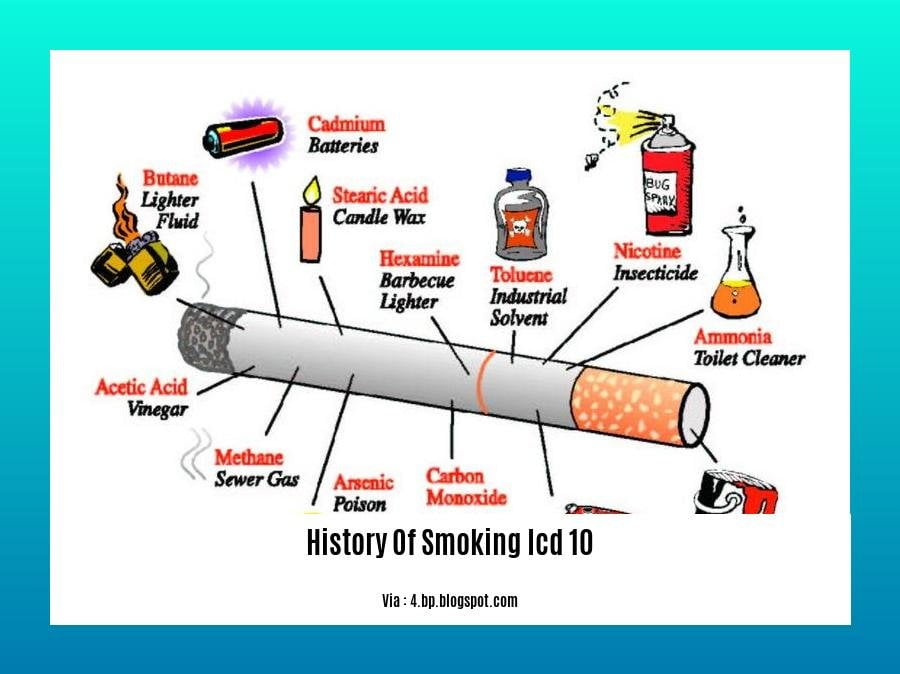Delve into the intricate tapestry of tobacco use throughout history, meticulously documented through ICD-10 codes. From the earliest records of smokeless tobacco to the rise and fall of cigar smoking, discover how societal attitudes and medical understanding have evolved in response to this prevalent habit. Witness the profound impact of smoking on public health, unraveling the intricate web of diseases and exploring the potential interventions that can mitigate its devastating toll. Join us on this enlightening journey through the annals of smoking, as we unlock the secrets held within ICD-10 codes to illuminate the path towards a healthier future.
Key Takeaways:
ICD-10 code Z87.891 represents an individual’s past dependence on nicotine.
This code is important for medical billing and insurance reimbursement purposes.
Data analysis using ICD-10 codes can uncover trends and patterns related to smoking-attributable diseases.
With this data, researchers and healthcare professionals can work towards developing interventions to minimize the burden of smoking-related illnesses.
Public health outcomes can be improved by using data to gain a deeper understanding of the history of smoking and its far-reaching impact.
History of Smoking ICD-10


Smoking, a significant public health concern, has a rich history dating back centuries. The history of smoking ICD-10 provides valuable insights into the evolution of this practice and its impact on public health. Let’s delve into the fascinating journey of smoking, exploring its origins and the role of ICD-10 codes in understanding its consequences.
A Journey Through Time: The Evolution of Smoking
Smoking’s origins can be traced back to ancient civilizations, with evidence suggesting its presence in various cultures across the globe. Initially used for ceremonial and religious purposes, smoking gradually became a social and recreational activity. The introduction of tobacco to Europe in the 16th century marked a turning point, leading to its widespread adoption and the rise of the tobacco industry.
The Health Consequences of Smoking: A Wake-Up Call
As the popularity of smoking grew, so did concerns about its health implications. In the 20th century, scientific evidence linking smoking to various diseases, including lung cancer, heart disease, and respiratory ailments, emerged. This led to significant public health campaigns aimed at reducing smoking prevalence.
ICD-10 Codes: A Tool for Understanding Smoking-Related Health Conditions
The International Classification of Diseases, 10th Revision (ICD-10), serves as a standardized system for classifying diseases and health conditions. ICD-10 codes provide a comprehensive framework for documenting smoking-related illnesses, enabling healthcare professionals and researchers to accurately track and analyze their prevalence and impact.
ICD-10 Codes Commonly Associated with Smoking
- Z87.891: Personal history of nicotine dependence
- I20: Hypertensive heart disease due to nicotine abuse
- I25.10: Ischemic heart disease due to nicotine abuse
- C00: Malignant neoplasm of lip, oral cavity, and pharynx
- C15: Malignant neoplasm of esophagus
- C34: Malignant neoplasm of lung and bronchus
The Power of Data: Using ICD-10 Codes for Public Health Research
ICD-10 codes play a crucial role in public health research on smoking. By analyzing large datasets containing ICD-10 codes, researchers can identify trends and patterns in smoking-related illnesses, assess the effectiveness of smoking cessation interventions, and evaluate the impact of tobacco control policies.
A Call to Action: Reducing the Burden of Smoking-Related Diseases
The history of smoking ICD-10 highlights the urgent need for continued efforts to reduce the prevalence of smoking and mitigate its detrimental effects on public health. Through comprehensive public health strategies, education, and support for smoking cessation, we can create a healthier future for generations to come.
Learn the incredible backstory of how a delicious chocolate bar with caramel and peanuts came to be in our lives. History of Snickers
Get the inside scoop on how soccer boots have evolved over time, from humble beginnings to the high-tech footwear we see today. History of Soccer Boots
Discover the fascinating journey of softball, from its humble origins in Chicago to becoming a beloved sport enjoyed by millions around the world. History of Softball
History of Cigar Smoking ICD-10
Cigars have a long and complex history, with evidence of their use dating back to the ancient Mayan civilization. In the 16th century, Spanish explorers introduced cigars to Europe, where they quickly became popular among the upper classes. By the 19th century, cigars were being mass-produced in Cuba and other parts of the Caribbean, and they were enjoyed by people all over the world.
In the United States, cigars were particularly popular among men in the 19th and early 20th centuries. They were seen as a symbol of wealth and power, and they were often smoked in public places such as bars, restaurants, and clubs. However, the popularity of cigars began to decline in the mid-20th century due to concerns about their health effects, such as cancer and heart disease.
Today, cigars are still smoked by a small minority of the population. In the United States, the Centers for Disease Control and Prevention (CDC) estimates that about 2.3% of adults smoke cigars. Cigars are more popular among men than women, and they are more likely to be smoked by people who live in rural areas.
The ICD-10 code Z87.891 is used to indicate a personal history of nicotine dependence, which includes cigar smoking. This code can be used for reimbursement purposes and to track the prevalence of smoking-related illnesses.
ICD-10 Codes for Cigar Smoking
There are a number of ICD-10 codes that can be used to indicate cigar smoking and its related conditions. These codes include:
- Z87.891 Personal history of nicotine dependence
- F17.22 Tobacco dependence
- I69.82 Chronic obstructive pulmonary disease due to tobacco smoking
- C34 Malignant neoplasm of lung
- I25.1 Ischemic heart disease due to tobacco use
- I63.4 Stroke due to tobacco use
Key Takeaways:
- Cigars have been smoked by people around the world for centuries.
- At one time, cigars were seen as a symbol of wealth and power, but today, they’re more likely to be associated with health concerns.
- The ICD-10 code Z87.891 is used to indicate a personal history of nicotine dependence, which includes cigar smoking.
- There are a number of other ICD-10 codes that can be used to identify cigar smoking and its related conditions.
Citations:
- ICD-10 code Z87.891 for Personal history of nicotine dependence
- Z87.891: Personal history of nicotine dependence
FAQ
Q1: What is the ICD-10 code for a personal history of nicotine dependence?
A1: The ICD-10 code for a personal history of nicotine dependence is Z87.891.
Q2: Is Z87.891 a billable code?
A2: Yes, Z87.891 is a billable code that can be used for reimbursement purposes.
Q3: What does Z87.891 indicate?
A3: Z87.891 indicates a personal history of nicotine dependence, and it is used to reflect the patient’s medical history accurately.
Q4: What is the history of ICD-10 codes for tobacco use?
A4: The history of ICD-10 codes for tobacco use dates back to the 1970s, when the World Health Organization (WHO) first introduced them. The codes have been updated several times since then to reflect changes in medical knowledge and practice.
Q5: How can ICD-10 codes be used to track the impact of smoking on public health?
A5: ICD-10 codes can be used to track the impact of smoking on public health by identifying trends and patterns in smoking-related illnesses. This information can be used to develop targeted interventions to reduce the burden of smoking-attributable diseases.




![[History of EMS Timeline]: A Journey from Humble Beginnings to Sophisticated Healthcare history-of-ems-timeline_2](https://www.lolaapp.com/wp-content/uploads/2023/12/history-of-ems-timeline_2-150x150.jpg)







